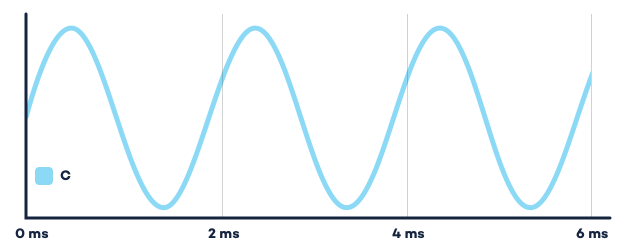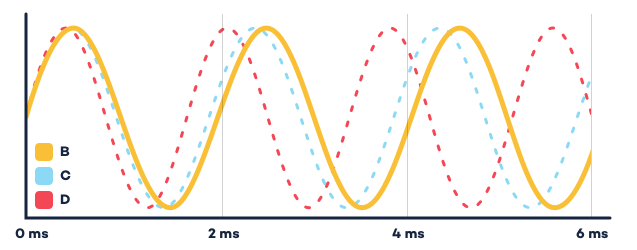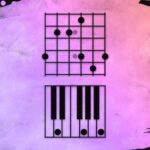Build Your Skills
Learn music theory Train your ears Track your tempoRead Now
Get the Newsletter
Categories
- | BeatMirror (10)
- | HearEQ (11)
- | Waay (23)
- | WaayFinder (1)
- Audio (16)
- For musicians (34)
- Guitar (2)
- Music theory (15)
- News (43)
- Startup stories (2)
- Tutorial (4)
Keep in Touch
About Ten Kettles
We love music, we love learning, and we love building brand new things. We are Ten Kettles.
Read more >-
June 16, 2021
Nature of a Note
What is a note, really? When we pluck a string on the guitar, how does that one little action end up as a sound to our ear? Discovering the nature of a note—the nature of sound—is an eye-opening adventure. It can give us a glimpse into the nature of music itself! We’ll begin our journey at the very beginning…
The Simplest Note
Take a listen to this very simple note:
This note is called “C” and it’s the simplest one you could imagine. It doesn’t sound like an instrument at all! The colour has been stripped away, leaving behind its most fundamental nature, it’s “C-ness.”
So what exactly is that fundamental “C-ness”?
Let’s start by looking around at the air. Seriously. Look away from this article and look really, really closely at the air all around you.
Through the Air
Air might seem empty at first, but it’s not empty at all. It’s jam-packed with little molecules that give us something to breathe—but also act as a pathway for sound. Now imagine that you see all the air molecules bouncing around, like a three-dimensional game of bumper cars. Take a moment and picture this. All these little molecules are chaotically bouncing into each other and rebounding away, only to bounce into more little molecules, and so on.
Got that mental picture? Now let’s consider the speaker that’s playing the C. Whether it’s your computer speaker or a pair of headphones, it’s doing the same thing. The little speaker starts smacking into the air molecules close by. Those molecules then rebound away, bumping into other molecules which bounce many of them back.

With every pulse of the speaker, nearby molecules collide into a dense pile. As more and more molecules smack into this dense pile, it starts moving along through the air, followed by a decidedly “undense” pile of molecules. In other words, high pressure air is being followed by low pressure air. And so this little parade of high and low pressure air—which we can call a “pressure wave,” or just “wave”—travels away from the speaker.
Arrival at the Ear
We are very fortunate to be fitted with a pressure-detection device right on our head! Two of them, in fact. They are our ears. Once the pressure wave reaches our ears, they detect how quickly the pressure goes from high to low. If it’s a fast change, then we hear a high sound. If it’s slow, then we hear a low sound.
What makes a note distinct from other kinds of sound—say conversation, traffic, or wind through the trees—is that its wave is a short, repeating pattern. The pressure increases, decreases, then does it all over again. For example, the pressure wave of our very simple C looks like this:

This particular pressure wave goes up and down about 523 times a second, so we’d say 523 Hertz, or Hz (Hz just means “per second”). But what happens if our speaker pulses faster? Well, our pressure wave would go up and down faster! So it would look like this:

This note is a D, which is one tone higher than our C. Here’s what it sounds like:
Hear the difference? The more frequently the note goes up and down—in other words, the higher its “frequency”—the higher it sounds to our ear. This new note goes up and down 587 times per second, so we’d say it has a frequency of 587 Hz.
What happens if the speaker pulses more slowly? The pressure wave might look something like this.

That note goes up and down more slowly than C or D, just 494 times per second, so we’d say it has a “lower frequency.” And because it has a lower frequency, it sounds lower to our ears. This one’s called a B, take a listen:
Wrapping Up
Here’s what we’ve learned so far. Playing a note—from a speaker, guitar string, or your vocal cords—pulses the instrument against the air. Each pulse creates a wave in the surrounding air molecules. And these waves radiate out from the instrument, eventually hitting your ear. Your ear is a very impressive pressure detection device. It interprets the rise and fall of air pressure as sound, and the higher the frequency, the higher the notes sound to us (and vice versa).
But that’s just the start of it. Stay tuned for the next stages of our investigation. We’ll look into what makes a guitar’s C sound different from the example above, why mixing notes together into a chord sounds good, and how you can use all this to write and mix your best music ever.
Keep Learning
Want to learn how to combine notes together into melodies, chords, progressions, and songs? Then Waay is for you.
Or maybe you want to start building your musical frequency skills to mix better music? Check out hearEQ.



Nice work, Alex. I have a book out where I cover a lot of these topics. I’ll send you some PDFs to preview of the upcoming 2nd edition.
Thanks, Chandler! And yes, I’d love to read your book. Looking forward to it.